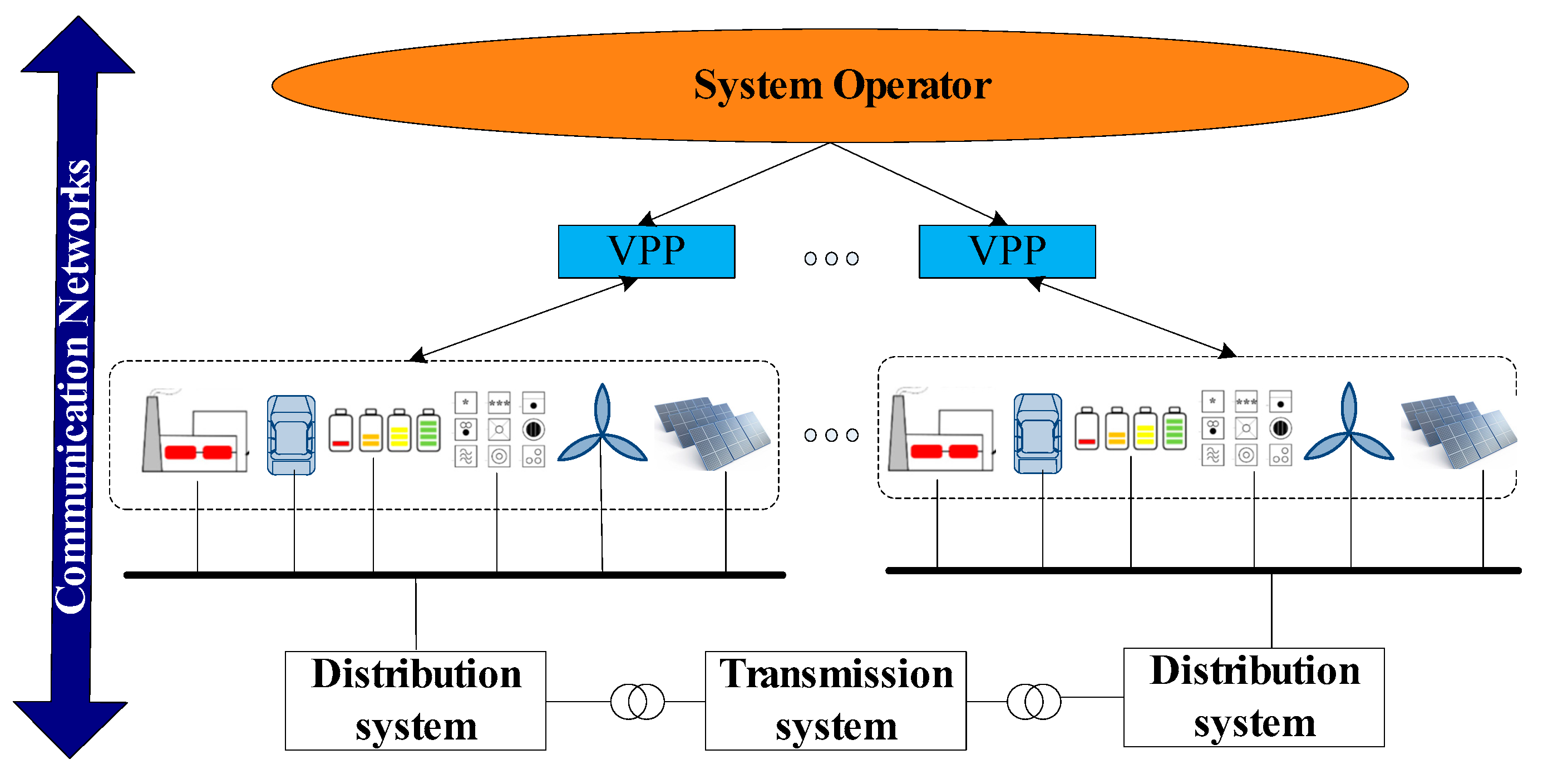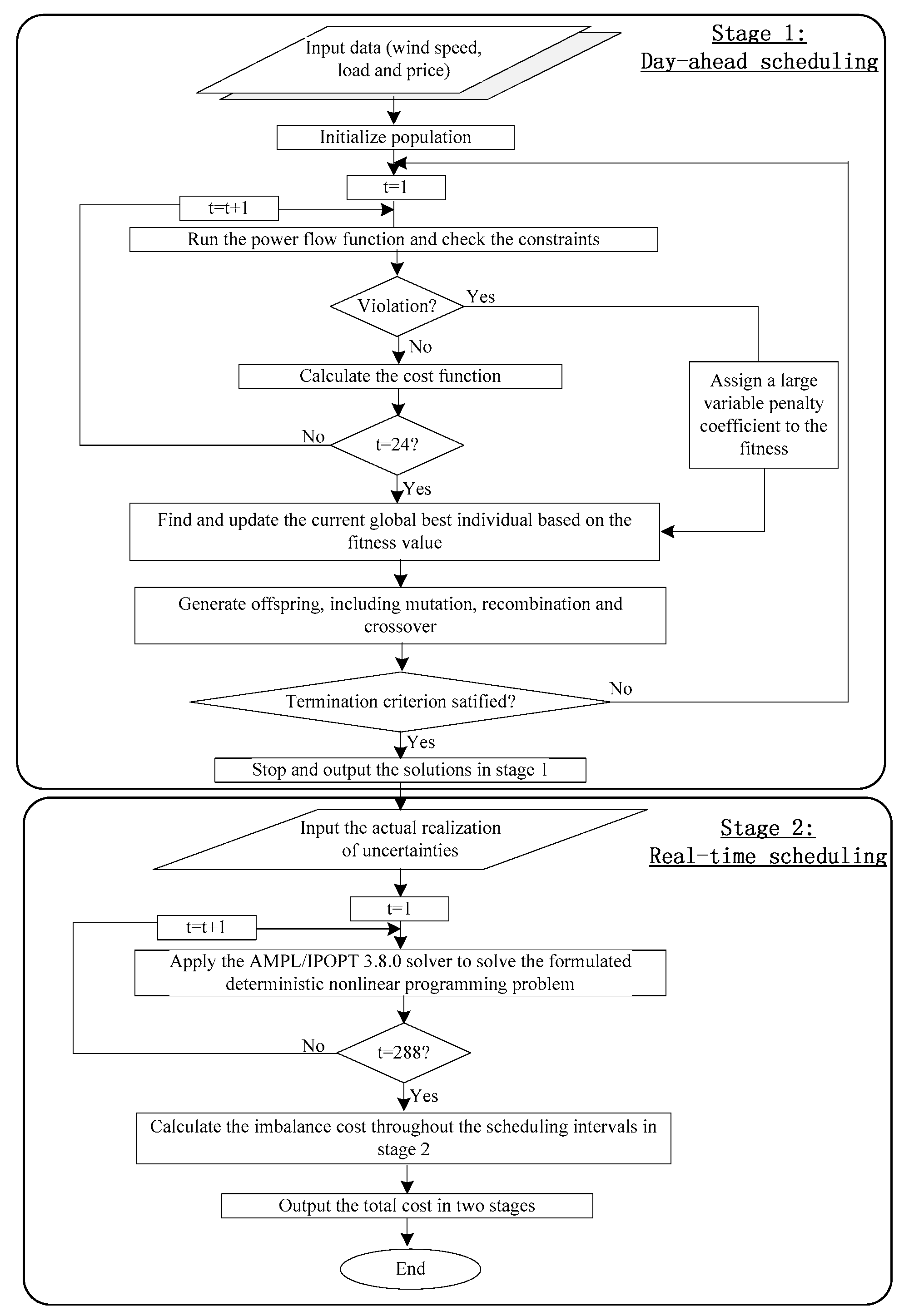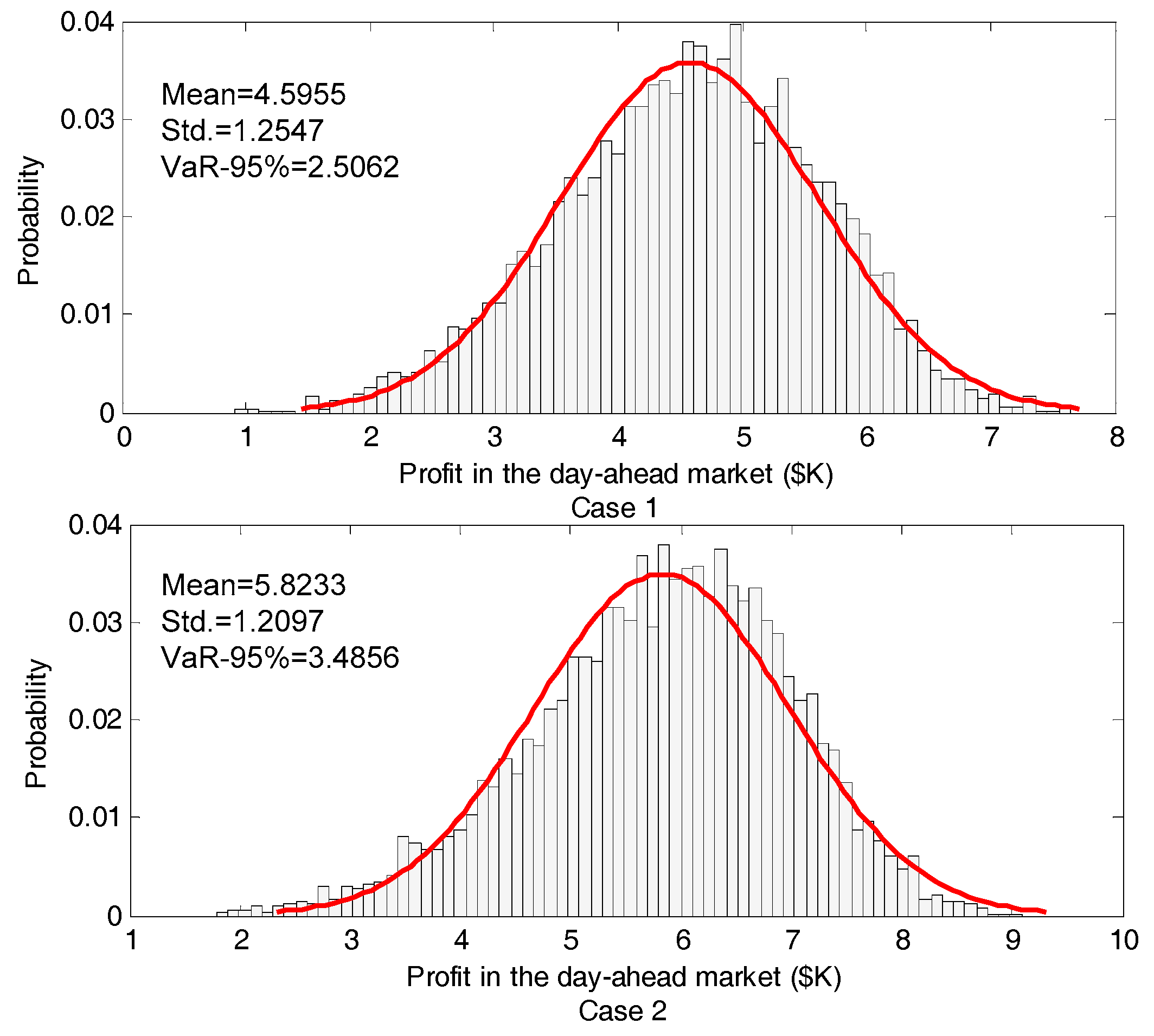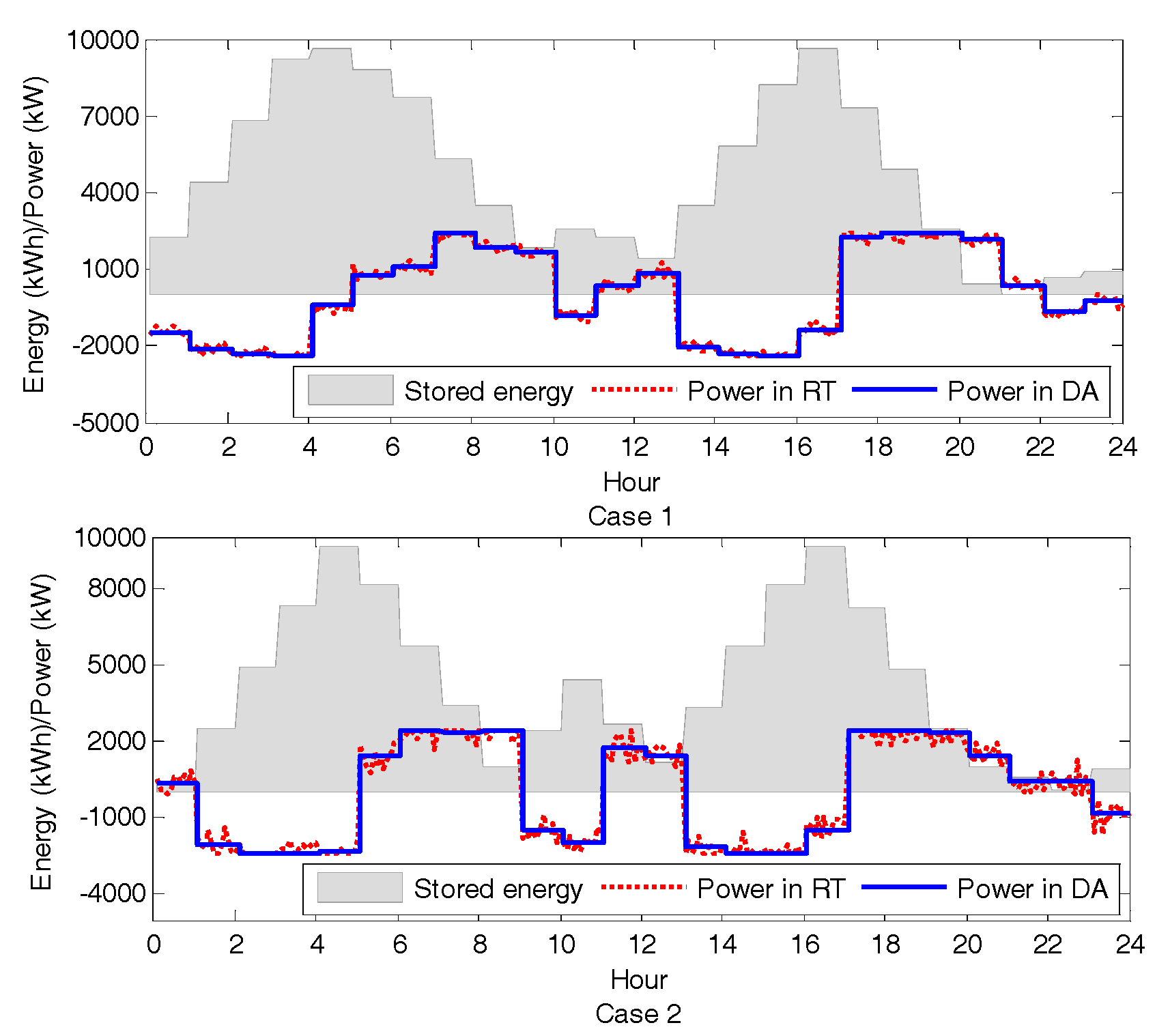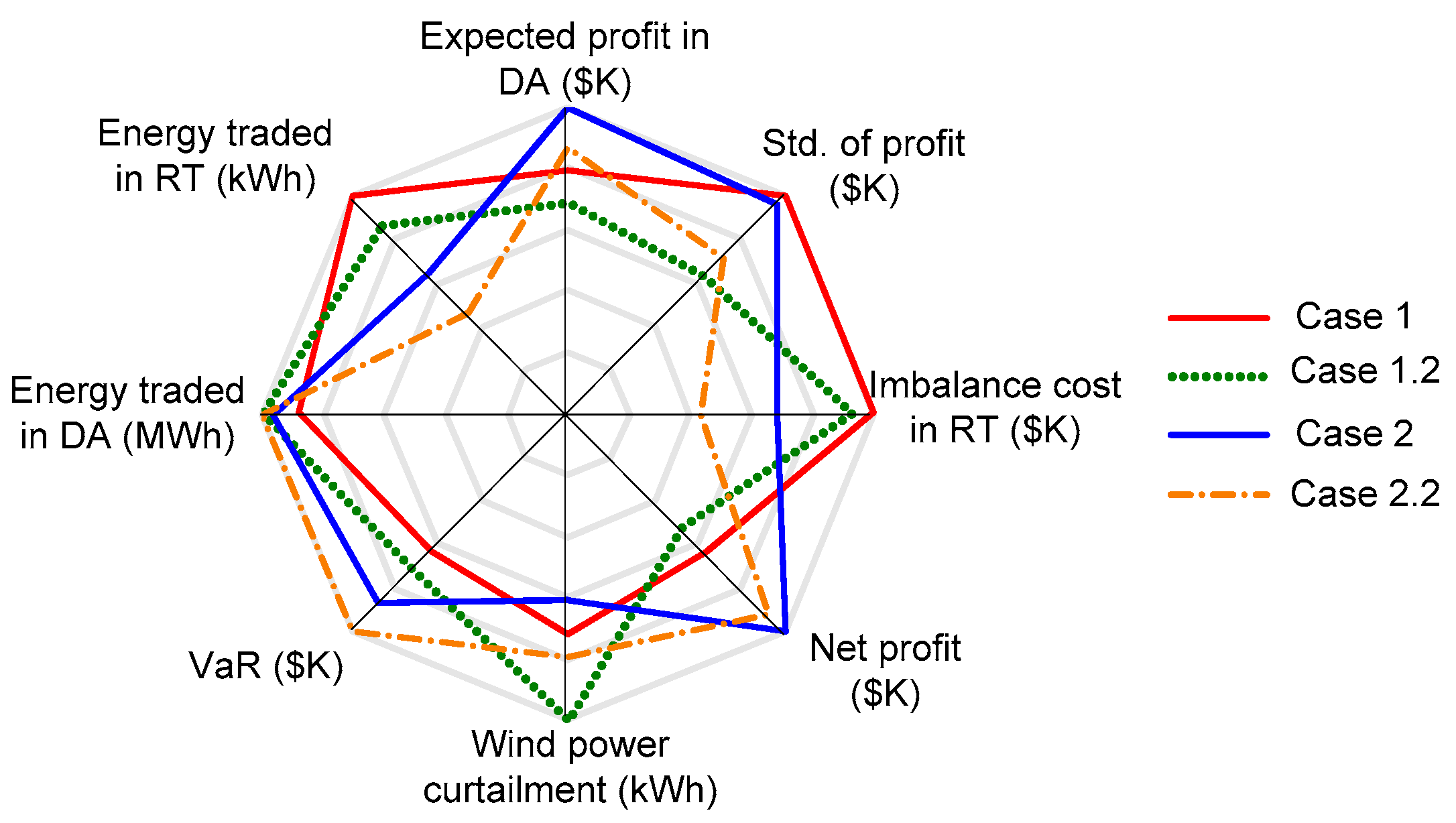5.1. Experimental Setting
The proposed VPP scheduling approach is tested on a real 12-bus distribution system of the CSIRO energy center in Newcastle, Australia. The VPP scheduling models are coded in MATLAB
® (R2015b, Chatswood, Australia). As seen in
Figure 3, the system is comprised of 4 wind turbines, 3 BESS, 3 DG units, and 11 load buses. The total generation capacity is 6500 kW, including 3000 kW of wind power and 3500 kW of DG. We assume that IL is located at every load bus, and up to 10% of the system load can be adjusted if necessary. The corresponding IL costs are composed of three bands, i.e., early morning (first 6 h), day time (middle 12 h) and evening (last 6 h). The capacity of power interconnection between VPP and the main grid is set as 4000 kW. The power curve of a Vestas V27 wind turbine is used [
16]. The rated, cut-in, and cut-out wind speeds are 14.0, 3.5 and 25.0 m/s, respectively. The start-up and shut-down costs of DG are assumed to be
$70 and
$20, respectively. In the base case, the weighting factor
is set to be 0.1. The correlated scenarios of market price, wind speed, and demand are modeled based on the Nord Pool historical data in 2015, which are publically available on [
34]. Note that the data have been scaled down and monetary units are transferred to US
$. The historical wind power production data in Denmark are used. The wind power output is calculated using the power-speed curve as [
35]:
where
and
denote wind power output and wind speed, respectively;
,
, and
denote cut-in, cut-out and rated wind speeds, respectively; and
denotes rated wind power.
5.2. Results and Discussion
To verify the effectiveness of the proposed model, two cases are compared. Case 1: An uncoordinated operation strategy. Individual VPP element operates strategically as a price-taker in the DA market, aiming to maximize their profits. The total profit is the summation of individual’s profit virtually obtained [
12]. The imbalance cost is calculated after the realization of scenarios. Case 2: The proposed integrated VPP scheduling approach.
The profit distributions in the DA market for Cases 1 and 2 are illustrated in
Figure 4. Compared to Case 1, the expected profit for Case 2 is higher (
$4595.50 for Case 1 and
$5823.30 for Case 2); while the standard deviation (Std.) for Case 2 is relatively lower. In addition, we use the Value-at-Risk (VaR) at a confidence level of 95% to evaluate the risk of different operational strategies. In other words, the VaR-95% denotes the expected value of the 5% scenarios with lowest profit. As seen in
Figure 4, the VaR is
$2506.20 and
$3485.60 for Cases 1 and 2, respectively. This implies that Case 2 incurs less risk in the DA market.
The iteration convergences of DE for Cases 1 and 2 are illustrated in
Figure 5. We can see that the DE solution algorithm requires 381 and 342 iterations for Cases 1 and 2, respectively, corresponding to computational time periods of 1982 and 1671 seconds on a PC with Intel Core i7-6600 CPU @ 2.80 GHZ with 8.00 GB RAM.
Moreover, the energy stored in BESS and the dis/charged power in the DA and RT markets are shown in
Figure 6. In both cases, BESS is charged in the early morning (e.g., 2–4 a.m.) or late afternoon (2–4 p.m.). BESS is discharged to satisfy the morning and evening peaks, when electricity prices are relatively higher. In other words, the profits made by BESS are based on the price differences between off-peak and on-peak periods. It is worth mentioning that power deviations in the two markets for Case 1 are smaller than Case 2. For the uncoordinated operation in Case 1, BESS only faces load uncertainty (i.e., load forecast errors). By contrast, for the aggregated VPP operation, BESS is required to cover the risks faced by other types of DERs and hence more power fluctuations are observed in Case 2. For instance, wind availability poses a significant risk to WP and WP is free from the market price volatility (generation cost for VPP is zero). On the contrary, wind availability is not an issue for thermal DG units, but DG operations are greatly influenced by market prices. Meanwhile, load uncertainty has more direct impacts on BESS and IL. Therefore, the coordination of VPP aims to share the risks of individual component, produce less power deviations, and make more profits in the markets.
Furthermore,
Figure 7 shows the summation of DERs’ power outputs (WP, BESS, IL and DG), demand, and the energy traded in the DA market. We can see that VPP produces more energy when price and demand are high; while VPP consumes energy in off-peak periods. For instance, the summation of DERs at 4 a.m. is nearly zero for both cases and VPP relies on the imported power from the grid to meet the base demand. Energy generated by WP and DG is mainly used to charge BESS. By contrast, VPP uses DERs (e.g., discharging BESS and using IL) and sells electricity to the grid at 7–8 a.m. and 6–8 p.m. More importantly, the coordination of VPP in Case 2 sells more energy in total, thus making more profits. This indicates that the aggregated production profile in Case 2 can better reduce the uncertainties of DERs and more energy surplus is produced.
The expected profits and imbalance costs in the DA and RT markets for Cases 1 and 2 are given in
Table 1 and
Table 2. It can be seen that more profits can be made for all DERs in Case 2. For DG and WP imbalance costs are lower in Case 2, but BESS and IL incur higher imbalance costs. This is because for the aggregated VPP operation BESS and IL are more frequently used to balance the fluctuations of WP. The imbalance cost of WP is markedly reduced from
$1426.80 to
$815.40. Overall, the net profits of DERs are much higher in Case 2 than those in Case 1. The total net profit is also higher in Case 2 (
$3002.00 in Case 1 and
$4737.30 in Case 2).
To demonstrate the impacts of different risk aversion levels, two more cases are added. Cases 1 and 2 are set with a higher weighting factor (
), i.e., Case 1.2 and Case 2.2. Eight indicators are compared in the radar chart in
Figure 8. Given the different scales, these indicators are presented in per unit (p.u.) based on the highest values in the four cases, i.e.,
$5823.30 = 1 p.u. expected profit;
$1254.70 = 1 p.u. Std. of profit;
$1593.50 = 1 p.u. imbalance cost;
$4737.30 = 1 p.u. net profit; 1586.66 kWh = 1 p.u. wind power curtailment (WPC);
$3982.30 = 1 p.u. VaR; 50.1463 MWh = 1 p.u. energy traded in DA; 1563.52 kWh = 1 p.u. energy traded in RT. As seen in
Figure 8, for a higher weighting factor (more risk-averse), VPP becomes more conservative, thus more energy is traded in the DA market. In the meantime, more WP is curtailed, and VPP is more willing to buy electricity from the grid. Besides, a higher risk-aversion level leads to lower profit, lower Std. of profit, lower imbalance cost, and higher VaR. This reveals the trade-off between profit and risk, and the VPP should make trading decisions based on its risk preference. Moreover, for the uncoordinated strategies (Cases 1 and 1.2), DERs earn less profit but are exposed to higher risks. Therefore, the proposed model can effectively reduce the risks in relation to uncertainties.
The four cases are expanded to another four cases (Cases 1.3, 1.4, 2.3 and 2.4). This is done by increasing the uncertainties by 10% (i.e., the forecast errors of market price, load and wind power are increased by 10%). As seen in
Table 3 and
Table 4, the increased uncertainties result in higher imbalance costs and lower VaR for both operation strategies, which means higher risks. This implies that the VPP should use more sophisticated forecast techniques to hedge against the profit variation risks if increased uncertainties are expected (e.g., increased WP penetration in the future or increased market volatility). Moreover, in a more uncertain environment, WP is less efficiently used (e.g., WPC is increased from 956.36 kWh in Case 2 to 1456.39 kWh in Case 2.3) and more energy is traded in the RT market. It is worth mentioning that for a more conservative strategy (cases 2.2 and 2.4), the reduction in the net profit caused by the increased uncertainties is the least (the net profits are
$4378.70 in Case 2.2 and
$4270.10 in Case 2.4). Besides, the net profit in Case 2.4 (
$4270.10) is higher than that in Case 2.3 (
$3620.10). This proves that the profit reduction due to risk-aversion is minimized by adopting a more conservative integrated VPP operational strategy. In other words, the cost in relation to risk-aversion is effectively reduced.
To investigate the correlation between risk aversion and uncertainty parameters, four more cases are added by combing the low and high values of risk aversion and uncertainty parameters. Specifically, low and high risk aversion values are set at
and
, respectively, while low and high uncertainty values are set by decreasing and increasing the uncertainties by 10%. Case 2.5 is defined as a low risk aversion and low uncertainty case; Case 2.6 is defined as a low risk aversion and high uncertainty case; Case 2.7 is defined as a high risk aversion and low uncertainty case; and Case 2.8 is defined as a high risk aversion and high uncertainty case. The detailed results of cases 2.5–2.8 are given in
Table 5. Based on the sensitivity analysis of risk aversion and uncertainty parameters, three findings can be identified in
Table 5. First, a high risk aversion value results in marked reductions in expected profit, net profit, and energy trades in both DA and RT markets. This is because that if the VPP is more conservative, the VPP is more likely to use the DERs such as DG and BESS to meet the local demands, rather than trading energy in the markets. Second, a higher uncertainty value results in relatively smaller reductions in expected profit, net profit, and energy trades in the DA market. However, a higher uncertainty value results in marked increases in imbalance cost, wind power curtailment and energy trades in the RT market. This implies that the higher uncertainty value is likely to increase the inaccuracy of DA scheduling plans of the VPP, and hence more energy imbalance is traded. Third, the risk aversion and uncertainty parameters can influence each other. A positive correlation is observed between them, since both higher risk aversion and uncertainty parameters can result in reductions in the objective value (i.e., the net profit).
Furthermore, the proposed VPP scheduling approach is compared to another approach proposed in [
16]. As seen in
Table 6, the net profits of the VPP are
$4737.30 and
$4099.10 for the two approaches respectively. This proves that the proposed approach is superior in terms of optimality. More importantly, since the approach in [
16] does not include any risk measure in the model, the risk of the VPP is marked higher (VaR for the approach in [
16] is
$2466.30 ). Note that a lower VaR means a higher risk of profit variability. Using the approach in [
16], the VPP cannot understand the trade-off between risk and profit, and identifies a scheduling solution that entails a higher market risk. In addition, the renewable energy is not efficiently utilized, as the wind power curtailment is 1726.39 kWh for the approach in [
16].
